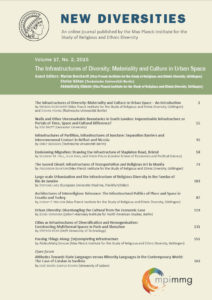Walls and Other Unremarkable Boundaries in South London: Impenetrable Infrastructure or Portals of Time, Space and Cultural Difference?
by Kim Knott (Lancaster University)
To cite this article: Knott, K. (2015). Walls and Other Unremarkable Boundaries in South London: Impenetrable Infrastructure or Portals of Time, Space and Cultural Difference? New Diversities, 17(2), 15–34. https://doi.org/10.58002/cvqw-5857
Seemingly impenetrable, urban walls, fences and other hard surfaces of the city do not seem likely contenders for social and cultural innovation and interaction. Generally, they remain unnoticed and unremarked upon. Yet broken, traversed, entered or excavated, they become visible and open to narration and imaginative (re)construction. These inconspicuous manmade structures, crucial for the management of urban life, for ensuring the efficient flow of people and traffic, and for securing public and private property, have counter-cultural potential. As boundaries for keeping people and objects out or in and for separating human activity on the surface from what is below ground, they may permit access to previously hidden times and places, and may allow new encounters to take place. Drawing on data from a research project on “Iconic Religion”, I eschew London’s iconic sites for the forgotten infrastructure in their shadows, and ask what new social relations and cultural imaginaries are generated by the wall separating a church from a market, a construction site behind a mosque, and a gate to a disused graveyard on land owned by Transport for London.
Keywords: social interaction, religion, boundaries, London, infrastructure
|
